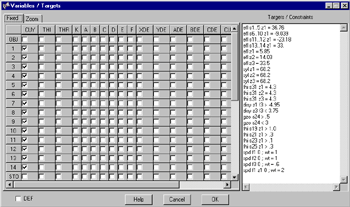Maker of the Optical Design Software OpTaliX
Optimization
Optimization of an optical system requires the solution of a highly nonlinear problem. It is the process by which the aberrations of a lens are minimized by changing selected lens data (variables). Two types of optimization algorithms are available;| KT - | optimization, minimizes an error function by a damped-least-square (DLS) method subject to solving constraints using Lagrange multipliers and application of the Kuhn-Tucker optimality condition, |
| LM - | optimization, solves a problem using a modified Levenberg-Marquardt algorithm. |
The merit function is constructed from almost any command relating to performance or construction data, thus allowing unlimited flexibility in the definition of the error function (also called a merit function). Besides minimization, boundary constraints accept logical operators like
= (equal),
< (less than)
> (greater than).
User-defined variables and functions will allow an even broader range of constraints in optimization, for example,
$z = [efl]+23.12
@xyz == [thi s2]+[thi s4]+$z
@xyz > 10
Defining Optimization Variables, Targets and Constraints

Edit variables, targets and constraints comfortably in a single window. The definition of a user merit function accepts all commands relating to surface data, system data and performance data. This includes arithmetic expressions, a large number of built-in mathematical functions and lens database items as also shown in the macro examples. See below a few examples of defining merit function elements:
| efl = 100 | Focal length (EFL) shall be precisely 100 mm. |
| syl < 70 | Constrain system length (first surface to last surface) to less than 70 mm. |
| spd f1..3 w3..4 0 | Minimize rms-spot diameter (spd) at field points 1 to 3 and wavelength numbers 3 to 4 (Target is 0). |
| spd 0 | As above, minimize rms-spot diameter. Absence of field and wavelength qualifier implies all fields and wavelengths. This is one of the easiest yet powerful optimization target. |
| thi s1 = [OAL] - 2*[thi s4] | Use arithmetic operators and lens database items given in [ ] brackets to define complex targets. |
| bfl = sqrt(tan(2)) | Use intrinsic functions to define complex targets. |
| @myfkn == [oal s1..6]-5.0 | Construct a user-defined function to be used later. |
| @myfkn > 10 | Use a previously defined funtion to define a constraint in optimization. |
Overview
Examples
- Non-Sequential
- Special Apertures
- Gradient Index
- Hologram
- Zoom
- Array Surfaces
- Fresnel Lens
- Light Pipe
- Global References
- Geometric Analysis
- Diffraction Analysis
- Interferogram
- Physical Optics (350kb)
- Fibers
- Optimization
- User Defined Graphics
- Glass Manager
- Coatings
- Macro Language
- ISO Element Drawing
- Surface Deformations
- Ghost Image Analysis
- Illumination